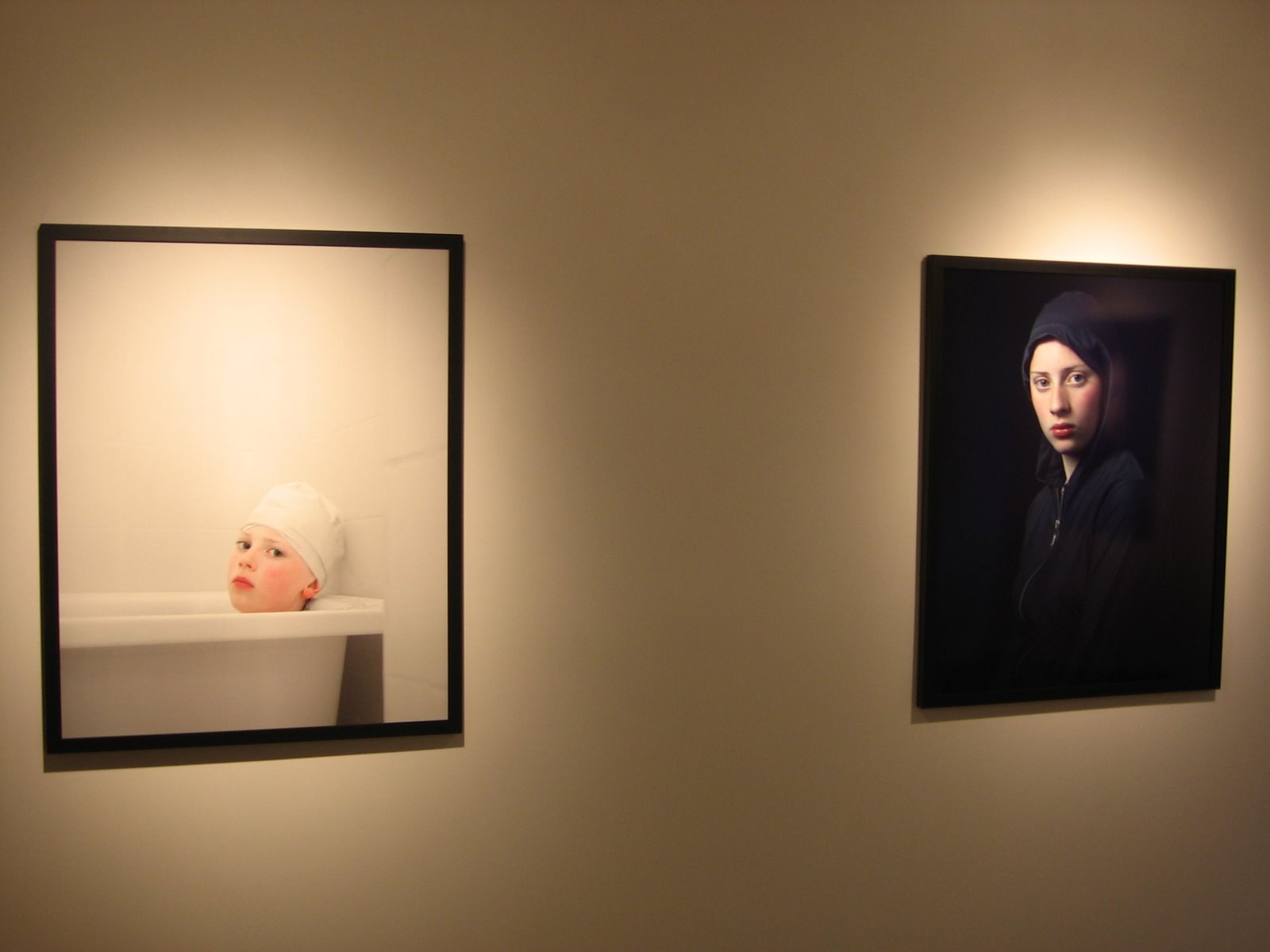 JTF (just the facts): A total of 7 c-prints, framed in black with no mat and no glass, hung in the single room gallery. All of the images were made between 1992 and 2008, and come in editions of 6 plus 2 APs. A video of Alexander McQueen’s Paris Fashion Week 2009 show runs in the corner; Kerstens apparently provided a photo for the invitation cover. (Installation shots at right.)
JTF (just the facts): A total of 7 c-prints, framed in black with no mat and no glass, hung in the single room gallery. All of the images were made between 1992 and 2008, and come in editions of 6 plus 2 APs. A video of Alexander McQueen’s Paris Fashion Week 2009 show runs in the corner; Kerstens apparently provided a photo for the invitation cover. (Installation shots at right.)
Comments/Context: This is the third time I have seen the recent portraits of Hendrik Kerstens this year (the other two were at Pulse (review here) and the Dutch Seen exhibit at the MCNY (review here)), and I’m still trying to get my head around why they are so captivating. If I took most people to the Renaissance painting galleries of a major art museum and asked them to comment on those pictures which were attributed to “School of” or “In the Style of”, the responses would likely center on the images being second rate knock-offs of the master, lacking in the special quality that elevated the work of the artist far beyond that of his/her pupils. So why then are Kerstens‘ portraits, which are so clearly and unmistakably drawn from the 17th century Dutch masters (Vermeer, Rembrandt et al), not simply a clever 21st century riff? (A similar question, with a slightly different answer, might be asked of Hiroshi Sugimoto’s spectacular waxworks portraits.)
 Part of the success of these portraits is their painstaking attention to the appropriate painterly detail of the period: for Kerstens, this means the exacting turned poses of his daughter Paula, the careful use of soft white light to create highlights and shadows, the sitter’s deadpan expression and her alabaster skin, heavy eyelids and full lips, and the focus on the texture of surrounding fabrics and props as a method for creating visual interest. (Sharon Core has worked through a similar set of details in her photographic still lifes after a 19th century American painter; review here). The key here is getting the specifics right, so that the visual echo to the original works comes through just enough for the viewer to register the connection.
Part of the success of these portraits is their painstaking attention to the appropriate painterly detail of the period: for Kerstens, this means the exacting turned poses of his daughter Paula, the careful use of soft white light to create highlights and shadows, the sitter’s deadpan expression and her alabaster skin, heavy eyelids and full lips, and the focus on the texture of surrounding fabrics and props as a method for creating visual interest. (Sharon Core has worked through a similar set of details in her photographic still lifes after a 19th century American painter; review here). The key here is getting the specifics right, so that the visual echo to the original works comes through just enough for the viewer to register the connection.
 The twist here is, of course, that Kerstens has added contemporary clothing and accoutrements to the images, creating a subtle clash of styles that creates the excitement. Paula is variously seen wearing a hoodie, a plastic bag, a sweater pulled over her head, and a lampshade, among other things. (The early image of a younger Paula in the tub with a bathing cap was to me a ringer for David’s Death of Marat.) The images are not simply period recreations; they have incorporated an updated visual vocabulary.
The twist here is, of course, that Kerstens has added contemporary clothing and accoutrements to the images, creating a subtle clash of styles that creates the excitement. Paula is variously seen wearing a hoodie, a plastic bag, a sweater pulled over her head, and a lampshade, among other things. (The early image of a younger Paula in the tub with a bathing cap was to me a ringer for David’s Death of Marat.) The images are not simply period recreations; they have incorporated an updated visual vocabulary. For me, some of the images have far too much contrast in them, the clash creating a perplexing misfit that doesn’t quite work. But in other cases, the juxtaposition of new and old meshes exquisitely, effectively mixing photo realism, antique painterly surfaces, and a dash of unexpected humor.
Collector’s POV: All of the images in the show are printed in three sizes: 24×20, 40×30, and 60×50. Prices range from $3100 to $20000, depending on the size and the place in the edition. Kerstens‘ work has not yet appeared on the secondary markets, so gallery retail is the place to go for follow up inquiries. While we are not portrait collectors, my favorite of the images on view is the one of Paula in a ruffled collar, sporting a stylish black pleated lampshade.
Rating: * (one star) GOOD (rating system described here)
Transit Hub:
Hendrik Kerstens
Through July 11th
547 West 27th Street
New York, NY 10001




